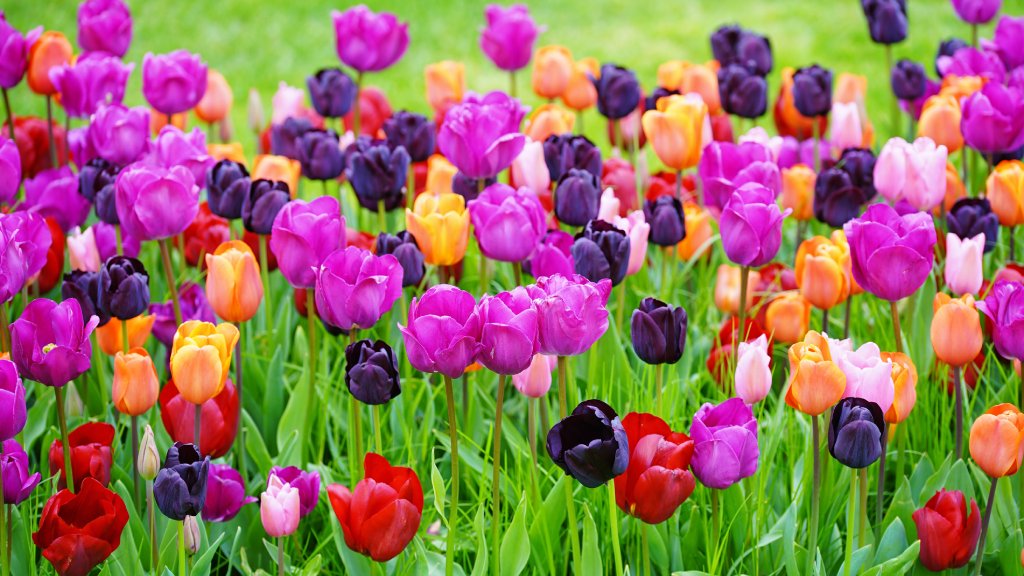Growing Tulips - Care And Tulip Planting Tips
For bright beauty every year in gardens or pots, learn all about planting tulips, storing the bulbs and caring for them when they've finished blooming.

Planting tulips is fun and rewarding. In the wild, tulips are native to the arid regions of Central Asia. The original species have a limited color range of mostly reds and yellows and tend to have smaller flowers than modern cultivars and hybrids.
Today’s tulips come in strong bright colors and pastel shades in a wide palette of colors for "painting" your garden. Tulips are among the most popular spring flowering bulbs. Available in a wide range of colors, tulips are among the first flowers to begin blooming in the spring. This makes these early-season plants a great choice for borders, cut flower gardens and containers.
Growing and caring for tulips is relatively simple, making them ideal for experienced and novice growers alike.
Quick Tulip Facts
Botanical Name | Tulipa |
Plant Type | Bulb |
Height | 12 to 24 inches (30 to 60 cm) |
Spread | 6 to 12 inches (15 to 30 cm) |
Light | Full sun |
Soil | Fertile; well-draining; pH 6.0 to 7.0 |
Hardiness | USDA zones 3 to 8. (Not in the US? Convert your zone) |
Flowers | Spring |
Native Range | A wide region stretching from Southern Europe and the Middle East to Central Asia |
Planting Tulips
Spring tulip bulbs already have an embryo flower tucked away inside. This embryo is just waiting to begin growing. When choosing tulip bulbs, make sure they are fat and firm. Avoid any bulbs that are soft, flabby, moldy, or whose papery cover is missing.
When to Plant Tulips
Buy tulip bulbs in late summer or early fall for the best selection, but wait until mid to late autumn to plant them. In mild winter areas, you can plant as late as December.
Tulips are eager growers, and planting too early will cause them to send up leaves before winter. Those tender shoots will likely freeze, which can damage the bulbs. To bloom properly, tulip bulbs require 12-16 weeks of “chilling” before spring.
Plant bulbs once soil temperatures stay consistently cool but before the ground freezes. In most climates, that means planting anytime through fall and into the early winter months, as long as the soil can still be worked.
Sign up for the Gardening Know How newsletter today and receive a free copy of our e-book "How to Grow Delicious Tomatoes".
Best Soil for Tulips
Tulips prefer soils that are neutral or slightly acidic. The bulbs can adapt to a wide range of soil types, including soil with sand or heavy clay but good drainage is essential to their growth. Wet or waterlogged soil is especially problematic throughout winter and can lead to a notable decline in bulb health.
Tulip Light Requirements
Tulips require full sun to grow their best. You can plant the bulbs under part-shade conditions, but this may cause the plants to stretch or become leggy as they reach for sunlight. They are happiest in full sun beds or, if necessary, under deciduous trees.
Step-by-Step Planting Guide
Begin prepping beds by digging the area and loosening the soil about a foot (30 cm) deep. You can add some compost or dried manure to the soil. Also, add some 5-10-5 or 5-10-10 granular fertilizer to help the bulbs grow. Mix the existing soil, amendments, and fertilizer until they’re well blended.
Create holes approximately 4-6 inches (10-15 cm) deep, planting each bulb with the growing tip pointing up. Fill in the beds with loose soil and water your new plantings well to encourage the growth of strong roots.There should be twice as much soil over the tip of the bulb as the height of the bulb, so if your tulip bulbs measure 2 ½ inches (5 cm) tall, dig your hole 8 inches (20 cm) deep, so you'll have 5 inches (13 cm.) of soil above the bulb.
Plant tulip bulbs in groups of ten if you're putting them in a perennial border, and space them a couple of inches (5 cm) apart. How you space the bulbs depends on the species. While bulbs that are being grown as annuals can be positioned relatively close together, perennial types may require more space. Cover the area with a mulch of pine bark or shredded leaves to protect the bulbs.
How to Care for Tulips
Tulips grow best when conditions are cool. After planting, dormant bulbs can withstand extreme temperatures throughout winter.
In the spring, new leaves can also withstand the cold, down to approximately 28F (-2 C) Prolonged exposure to cold temperatures beyond freezing may cause damage to flower buds, as well as the complete loss of plants.
The ideal temperatures throughout the plant’s bloom period range between 50-60 F (10-15 C).
Watering Tulips
Tulip bulbs benefit from watering directly after planting. However, watering should stop as the weather begins to cool in the fall. Avoid watering tulip bulbs during the winter, as excess moisture may lead to rot and/or the development of disease. As soon as leaves begin to emerge from the soil in spring you can resume watering.
Fertilizing Tulips
Apply fertilizer to your tulip bulbs at planting time and in early spring. Many tulip growers advocate for a balanced, slow-release feed in the fall to help with developing roots. In spring, a dose of high-nitrogen fertilizer promotes vigorous new growth.
Pruning
Tulip plants can be pruned or deadheaded after the plant’s flower has faded. To remove the flower, follow the bloom’s stem back to its base and carefully snip it from the plant. This will prevent the production of seed, and help the remaining leaves gather energy for forming new flower bulbs.
Storing Tulip Bulbs
Commercial tulip growers dig and store bulbs throughout the summer until they can be sold or replanted in the fall. Home gardeners can mimic this process by removing tulip plants from the soil and allowing them to properly dry throughout summer. Store tulip bulbs in paper bags and keep them in a cool place.
It’s essential to provide your bulbs with proper storage conditions. If possible, you should keep tulip bulbs in your refrigerator's crisper drawer. However, don't store them with apples and other fruit. Apples and bananas give off ethylene gas, which helps fruit ripen but kills the flower bud inside any bulbs.
Don't put tulip bulbs in the freezer; it will kill them. Instead, keep the bulbs dry and in a cool, well-ventilated area like an unheated garage.
Types of Tulips
Like most flower types, the needs and behavior of tulips vary depending on the species. Most common garden varieties will perform best when grown as annuals. Annual tulips are highly diverse with a wide range of color, structure, and bloom periods.
More specialized perennial types may be a good option for establishing perennialized flower beds or lawns. Learning more about each specific tulip species is key to ensuring the best results possible.
Propagating Tulips
Though some species can be grown from seed, most garden variety tulips are the direct result of extensive hybridization. Seeds saved from tulip plants seldom grow true-to-type and often require several years before they’ll produce flowers. If you want to save bulbs from your favorite tulips, allow the plants to remain in the garden until they’ve died back naturally. Then lift the bulbs from the soil and divide them.
Common Problems
Issues related to watering are some of the most common problems that affect tulips. Rot and other fungal diseases can also lead to the loss of large numbers of tulip bulbs. Bulbs that have been improperly stored may develop mold or viruses. At planting time, it’s important to discard any diseased or infected bulbs.
Common garden pests can also pose a significant threat to tulip bulbs. Mice, voles, squirrels, and deer are all known to cause frequent damage to tulip plantings.
Planting Tulips in Pots
Tulips can withstand quite a bit of cold, making them ideal for growing in containers and pots. Much like their garden counterparts, container-grown tulips require a quality potting mix that drains well. Tulip bulbs in pots can be planted at a depth approximately twice the height of each bulb. Potted tulip bulbs can be left to overwinter outdoors, or can be moved to a more sheltered location such as an unheated porch or garage.
How to Force Tulips Indoors
The term “forcing” refers to the process of growing tulips indoors throughout winter. Growing tulips indoors is a fun and easy way to enjoy these beautiful flowers throughout even the most inhospitable weather.
Tightly pack pre-chilled tulip bulbs, or those that have been cold treated, into containers or small pots. Place the pots in a warm location that receives ample indirect light. Forced bulbs will begin growing within 1-2 weeks, ultimately producing a bright, vibrant display of indoor color.

Heather Rhoades founded Gardening Know How in 2007. She holds degrees from Cleveland State University and Northern Kentucky University. She is an avid gardener with a passion for community, and is a recipient of the Master Gardeners of Ohio Lifetime Achievement Award.

